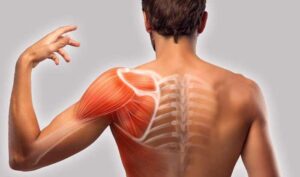Living with scapular pain can feel like carrying an unwelcome passenger that hinders your daily life activities. The scapula, also known as the shoulder blade, plays a crucial role in almost every arm movement, and pain in this area can be both debilitating and frustrating. Our comprehensive guide delves into understanding back scapula pain more profoundly, discussing the causes, symptoms, and most importantly, the solutions.
Contents
What Does Back Scapula Pain Define?
 Back scapula pain, also known as shoulder blade pain, is discomfort or aching sensations experienced in or around the area of your scapulae. The scapulae, commonly referred to as shoulder blades, are flat, triangular bones located at the back of your shoulders. And serve as the foundation for arm movements.
Back scapula pain, also known as shoulder blade pain, is discomfort or aching sensations experienced in or around the area of your scapulae. The scapulae, commonly referred to as shoulder blades, are flat, triangular bones located at the back of your shoulders. And serve as the foundation for arm movements.
This pain can be dull and constant, sharp and intermittent, or some variation thereof, depending on its source. It’s important to note that because the shoulder blades are closely connected to the spine and neck via muscles and ligaments, scapular pain often correlates with issues in these areas as well. Understanding the source of the pain is crucial for effective treatment and relief.
What Are The Symptoms To Know?
Recognizing the symptoms associated with scapular pain is key to understanding your condition and seeking appropriate treatment. The nature and intensity of symptoms can vary widely depending on the underlying cause. Here are some common symptoms you may experience:
- Pain in the Shoulder Blade Area
This is the most prominent symptom. The pain can be sharp, dull, burning, or aching, and it may be constant or intermittent. It may also worsen with certain movements or positions.
- Pain Radiating to Other Areas
Depending on the cause, scapular pain can radiate to other areas such as the neck, arms, chest, or even the jaw. This is common in conditions such as heart or lung problems where the pain is referred from other areas.
- Limited Range of Motion
You may experience difficulty or discomfort when moving your arm or shoulder. This can also be accompanied by stiffness in the shoulder or neck.
- Swelling or Redness
These can be signs of an injury or infection affecting the scapula area.
- Muscle Weakness or Atrophy
In some cases, muscle weakness or a noticeable decrease in muscle mass around the shoulder can be associated with scapular pain.
- Tingling or Numbness
These sensations may be experienced in the arm, hand, or fingers and are usually indicative of a nerve-related issue.
- Clicking or Popping Sounds
These sounds may be heard during shoulder movements and could indicate a problem with the joints.
- Changes in Posture
Some conditions can lead to visible changes in posture. Such as rounded or forward-leaning shoulders.
If you experience any of these symptoms, particularly if they persist or worsen, it’s crucial to seek medical advice. A healthcare professional can help you identify the cause of your symptoms and recommend the best course of treatment.
What Causes Pain Behind The Scapula?
 Pain behind the scapula, or shoulder blade, can be caused by various conditions that range from musculoskeletal to systemic disorders. Some common causes include:
Pain behind the scapula, or shoulder blade, can be caused by various conditions that range from musculoskeletal to systemic disorders. Some common causes include:
- Musculoskeletal Conditions: These are one of the most common causes of scapular pain. Conditions such as rotator cuff injuries, frozen shoulder, and tendonitis can lead to discomfort in the shoulder blade area.
- Poor Posture: Maintaining poor posture for extended periods, particularly during work or when using electronic devices, can lead to muscle imbalances and strain around the shoulder blades.
- Overuse or Strain: Repeated use or overexertion of the shoulder and back muscles, often seen in athletes or individuals who perform repetitive arm movements, can result in pain.
- Neck Conditions: Issues in the cervical spine, such as herniated discs or neck arthritis. This can lead to referred pain in the scapular area.
- Trauma or Injury: Direct injuries to the shoulder or scapula. Such as a fall or blow, which can cause immediate and severe pain.
- Nerve Impingement: Conditions like a pinched nerve in the neck or thoracic outlet syndrome can cause pain, numbness, or tingling sensations in the shoulder, arm, and scapula.
- Osteoarthritis: Degenerative changes in the joints around the scapula, like the acromioclavicular joint, can cause pain.
- Gallbladder Disease: In some cases, gallstones or inflammation of the gallbladder can cause referred pain in the right shoulder blade.
- Heart Conditions: Although less common, conditions like heart disease or a heart attack can cause referred pain to the left shoulder blade.
- Lung Conditions: Certain lung conditions like lung cancer or pneumothorax (collapsed lung) can also cause referred pain to the shoulder blades.
Given the range of possible causes, it’s crucial to have scapular pain evaluated by a healthcare professional. They can help determine the underlying issue and recommend appropriate treatment.
How Do You Get Rid Of Back Scapula Pain?
The treatment of back scapula pain primarily depends on identifying and addressing its underlying cause. Here are some general strategies that may help:
- Rest
Allow your body to heal by taking a break from activities that may be exacerbating your pain.
- Pain Relief Medication
Over-the-counter nonsteroidal anti-inflammatory drugs (NSAIDs) like ibuprofen or aspirin may help relieve pain and inflammation. Always follow the dosing instructions and consult your doctor if your symptoms persist.
A physical therapist can teach you exercises to strengthen the muscles around your shoulder blade, improve your posture, and increase your range of motion.
- Heat and Cold Therapy
Applying heat can help to relax tense muscles and relieve pain, while cold can help to reduce inflammation. Alternating between heat and cold may also be beneficial.
- Exercise and Stretching
Regular exercise, especially exercises that strengthen the back and shoulder muscles, can help prevent and reduce scapula pain.
- Massage
A professional massage therapist may help to relieve tension and pain in the muscles surrounding your scapula.
- Maintain Good Posture
Paying attention to your posture, especially if you sit for long periods, can help prevent and alleviate pain. Make sure your workstation is ergonomically friendly.
- Lifestyle Modifications
Maintaining a healthy weight, quitting smoking, and managing stress effectively can also contribute to overall musculoskeletal health and pain reduction.
- Surgery
In severe cases, especially when the pain is caused by structural problems, surgery might be necessary.
Remember, these are general strategies, and their effectiveness will depend on the underlying cause of your scapular pain. Always consult a healthcare professional for a proper diagnosis and treatment plan tailored to your condition.
Does Scapula Pain Go Away?
 Back scapula pain can indeed go away. But how long it takes and the treatment required depends largely on the cause of the pain.
Back scapula pain can indeed go away. But how long it takes and the treatment required depends largely on the cause of the pain.
For example, scapular pain caused by a muscle strain due to overuse or poor posture might improve relatively quickly with rest, physical therapy, and changes in habits. On the other hand, scapular pain caused by conditions like arthritis, or certain diseases may take longer to resolve and might require more extensive treatment.
It’s important to consult with a healthcare professional if you’re experiencing scapular pain. They can help diagnose the underlying cause of the pain and provide appropriate treatment options. With proper care and management, most people can experience significant relief from scapular pain.
Conclusion
In conclusion, back scapula pain, while common, should never be overlooked or minimized due to its potential to significantly impact one’s quality of life. Understanding the anatomy and function of the scapula, recognizing the symptoms of scapular pain, and being aware of its diverse causes are the initial steps toward effective management. Therapeutic interventions and potential surgery are available based on the specific cause of the discomfort.
Enduring pain is not a norm, so consult with a healthcare professional if you’re experiencing persistent scapular pain. Together, through knowledge, prevention, and appropriate treatment, we can conquer scapular pain, enabling a healthier, more active lifestyle.
If you’re experiencing Back pain, physical therapy for back pain at PhysioMantra can help: Book an online physical therapy session.



